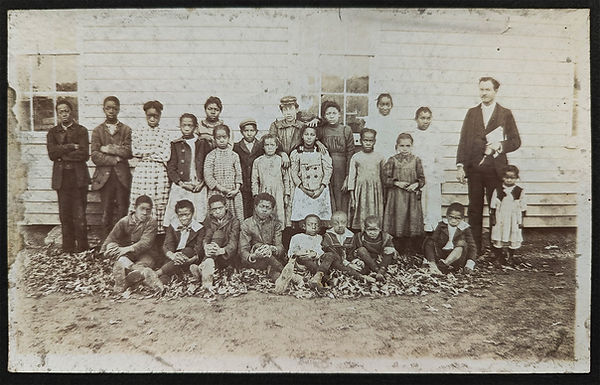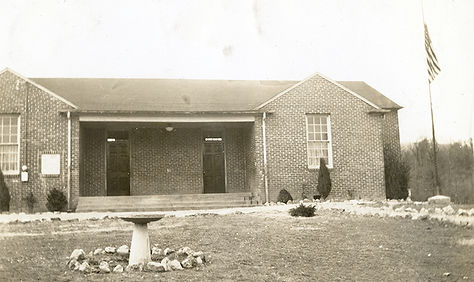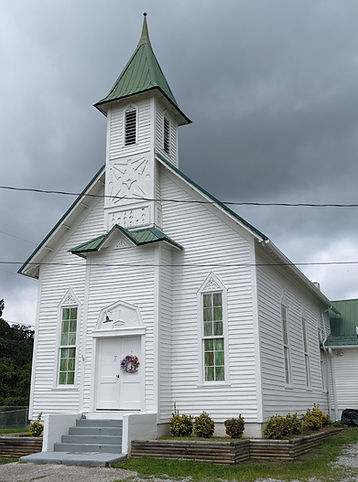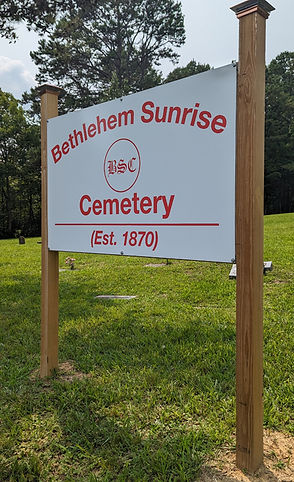Knox County, Tennessee
Lesser known than the city of Knoxville's Black histories, the families of the rural Black communities of Knox County arrived in the area before the formation of what would be the State of Tennessee. Free and enslaved people labored in the landscape as the most significant Black population in the region, second to only Chattanooga.
This page is a compilation of research and materials associated with the communities of Concord, Happy Home, High Top, Mascot, Oakland & Sunrise. Though distinct in their footprint, there was a great amount of interconnection between these spaces. Migration between these four communities, the intermarriage between families and the sharing of teachers and preachers as well as burial grounds occurred throughout their histories.
Concord
The original Freed People in the area were the formerly enslaved families from the Mabry Plantation in West Knox County. These newly emancipated families were given land around the Loop Road area and began the establishment of churches and a school. Early family surnames included Kyer, Bacon, Moulden and Claiborne. Eventually the Concord AME Zion and a Church of God were established in the community.
It’s been indicated that Concord’s Black school may have been the first free school for African Americans in the state of Tennessee. The first records of the school that we have access to are the Enumerations of the students, grouped by parents and organized by Male & Female columns. Those records span 1883 to 1885 with surnames: Armstrong, Britton, Brown, Callaway, Click, Cox, Crookshanks, Cunningham, Cross, Davis, Edington, Easley, Dalton, Fox, Franklin, Galbreath, Gourley, Green, Hardin, Hall, Henderson, Hemphill, Henry, Hoard, Johnson, Lightle, Lenior, Looney, Low, Miller, McDowell, Mourfield, Nelson, Phillips, Porter, Pruitt, Ragland, Reece, Rice, Russell, Sanders, Stone, Tedford, Tillery, Vaughn, Wagner, Wallace, West, Youst.
Many of the incoming Black families of Concord came to work in agriculture, the railroad and marble quarry industry. The community continued to host annual Homecomings and Reunions the first Saturday of August, up until, least the 1990's.

Concord Elementary School Students & teacher, Will Hardin. 1900
Happy Home
Established around 1918, just West of Knoxville-proper, the Happy Home community. Tucked back off Middlebrook Pike, the families there first came to the attention of journalists some 23 years after it's founding. The attention in the article by New Sentinel writer Lee Davis focused on the anomalous production of cotton fields there. In it's hay day, Happy Home had a Rosenwald schoolhouse, taught then by Edith Alden. Bethlehem Star Baptist Church served their spiritual needs. The largely agricultural community was founded by farm workers Andrew Jackson, Alvin Lundy and William Rucker. There is also a strong musical tradition in Happy Home, as evidenced by the decades of performances by the Happy Home Jubilee Singers and their own Knoxville-based radio show.
Click image below for Knoxville News Sentinel Article, 09/27/1998
Click above image for
Knoxville News Sentinel Article, 10/04/1942
High Top
Currently, we're working with families in and from High Top to provide a more robust history of this early Black community.




Mascot
Founded around 1913 by the American Zinc Company of Tennessee, Mascot was developed as a mining community for the extraction of Zinc for industrial and agricultural uses. In 2025, the Calvin M. McClung Historical Collection of the Knox County Public Library system digitized and made publicly available copies of “Mascot Concentrates” Magazine. That publication was produced by the American Zinc Company of Tennessee and that collection spans from 1919 to 1920. Those company newsletters included articles dedicated to the Mascot’s Black Community, often entitled “In The Colored Village”.
Here is a brief summary of information sourced from those articles.


In 1920, the mining town touted a Black School with around 38 students, a Colored Hall for social activities, a crack baseball team called the Mascot Reds, as well as a Colored House of Representatives, an effort toward "industrial democracy".
There was also a labor relationship with the nearby Black farming enclave known as Sunrise. Individuals from there listed in the 1920 census expands the scope of mine’s economy and diversifies the numbers on housing. Twelve workers, or 7.5%, were homeowners, while the vast majority of American Zinc Company employees were renters, 92.5%. All of the home-owning workers lived in the area of Washington Pike, Rutledge Pike and Millertown Road. Exactly half of the Black mine workers in the 13th District lived in a family unit, with at least a wife. The other half were largely single men, boarding in the homes of others.
Oakland Community
Located in northern Knox County, just outside of Fountain City, the Oakland Community started to take shape not long after the US Civil War as newly emancipated families began the forming new communities. Black people from places such as Upstate South Carolina, Knox and Union Counties of Tennessee joined together to build two churches; Foster Chapel and Oakland AME Zion and an elementary school to serve the needs of their children. Fraternal organizations such as The Band of Mercy, The United Brotherhood of Friendship and the Sisters of the Mysterious Ten and the Free Masons provided additional social and philanthropic activities. Small businesses such as stores and boarding houses were established as well as four final resting places; Mysterious Ten, Band of Mercy, Oakland AME Zion and Foster cemeteries. In collaboration with Pat Harris, Foster Chapel Historian, and descendants, we've managed to compile a significant amount of research and information on this important community.
Oakland Elementary School


1891 is the earliest documentation we know of Oakland (Colored) Elementary School being in operation. Oral histories suggest that educational efforts in the community may have occurred in peoples' homes in the 1870's.
Timeline of Oakland Educators & Key Events:
1895 to 1897 - Mitchell F. Burke
1898 - J.S. Scott
1899 - Mitchell F. Burke
1900 to 1904: Granville Stanley Hurd
1905 - School was discontinued due to low enrollment
1906 - Mary May Burks Daniel
1908 - School was formally re-established
1908 - Matilda Holland
1909 - Mary May Burks Daniel
1920 - Selma Flack
1923 - Bessie Jackson
1924 to 1928 - Willie Thompson
1930 - Carry Lou Hardy
1936 - School was rebuilt by the Works Progress Administration
1935 to 1939 - Brazil Helen Seguines Hunt
1935 to1954 - Talitha Catherine Dennis
1941 - Lillian Armstrong
1965 - School was closed due to intergration
Present Day - Building a community center managed by Knox County
Mysterious Ten Cemetery
In 2025, Black in Appalachia took on the task of cleaning up and restoring Oakland's Mysterious Ten Cemetery. This historic burial site is the final resting place of many poor and working class residents who lived in the Knoxville neighborhood once known as The Bottom. The Sisters of the Mysterious Ten were the women's auxiliary of The United Brotherhood of Friendship, a fraternal organization founded before the US Civil War by enslaved and Free African Americans. After Emancipation, this fraternal entity would see robust expansion and membership totaling in the tens of thousands. The Sisters of the Mysterious Ten provided philanthropic and charity support for Black families post-Reconstruction that included burial assistance for it's members.
The stories contained in the cemetery include that of Reverend Shepherd J. Jordan, who assumed pastoral duties at Oakland's Foster Chapel in 1935. There, he oversaw the installation of a new brick edifice around the wooden frame church. There's also Mr. Patrick Henry Venable, a Virginia-born brick mason that was reportedly the first member of the Bricklayers Union. He arrived in Knox County in 1885 and contributed his hands to an unknown number of buildings in the area during his 40 year career.
The on-going work of this project includes clearing out brush and downed trees, restoration of fallen tombstones, researching the narratives of those buried and the installation of signage and site interpretation. If interested in volunteering, email us at info[at]blackinappalachia.org








Sunrise
Out of all of Knox County's rural Black communities, there is probably less documentation of Sunrise than most. Founded just after the US Civil war by newly Freed People mostly from surrounding counties, particularity Grainger and Hawkins, as well as families from North & South Carolina. In 1870, the area was designated as Roseberry, named for its post office, also known as Knox County District 14. Surnames that decade included Bassett, Bradley, Cardwell, Cobb, Cox, Cooper, Howell, McMillan, Miller, Nance, Netherland, Shipe, Sumner, Whiteside. Some of those Black individuals lived with white families with the same last name, which could indicate they were their former slaveholder. As the decades progressed, this largely agricultural community expanded and included a school and several churches including Rising Sun Methodist Episcopal Church.

Sunrise Rosenwald School




